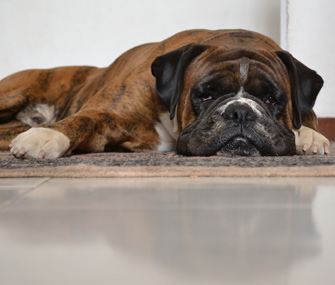Spotting, Diagnosing and Treating Hypothyroidism in Dogs
Published on April 29, 2016
Skip To

Those vague signs may be old age creeping up, but then again, they could be a common hormonal disorder in middle-aged and older dogs: hypothyroidism. As dogs age, their levels of thyroid hormone can decrease when the thyroid glands, located in the neck, either shrink or become inflamed. One form, called autoimmune thyroiditis, occurs when a dog’s immune system attacks and destroys the thyroid gland.
The deficiency of thyroid hormone results in a decreased metabolic rate and affects the function of many organ systems. That’s why signs of hypothyroidism vary so widely, from a lack of energy and mental dullness to skin problems, such as a dry, scaly, itchy or greasy coat, and hair loss. Dogs may be more prone to skin and ear infections.
Affected Dogs
Hypothyroidism is seen in other species, including humans, but it is very common in dogs. Your veterinarian may suspect hypothyroidism if you have a midsize to large dog who is 4 to 10 years old.Although any dog breed can be affected, breeds in which the disease is often seen include Airedale Terriers, Boxers, Cocker Spaniels, Dachshunds, Doberman Pinschers, Golden Retrievers, Irish Setters and Miniature Schnauzers.
Signs can be different from dog to dog. In some dogs, the hair may fall out spontaneously or fail to regrow after being clipped. The hair loss usually occurs on both sides of the body, and the remaining hair often feels dry and brittle. In others, common signs of the disease include hair loss, weight gain, lethargy and itchy skin.
Diagnosis and Treatment
Hypothyroidism is sometimes difficult to recognize, because its signs are common to many other conditions as well. Your veterinarian will likely suggest running a special panel of thyroid tests.The good news is that hypothyroidism is readily treatable with synthetic thyroid hormone. The pill must be given daily for the rest of the dog’s life. Medication may be given twice daily at first, then reduced to a single dose per day, although some dogs may require twice-daily treatment.
Typically, you’ll begin to see improvement four to eight weeks after your dog begins taking medication. Your veterinarian may run follow-up blood tests to see if the dose of medication should be adjusted up or down. From then on, your veterinarian may recommend periodic blood tests to make sure the medication is still doing its job and that your dog’s body is absorbing and metabolizing it well.
More on Vetstreet:

